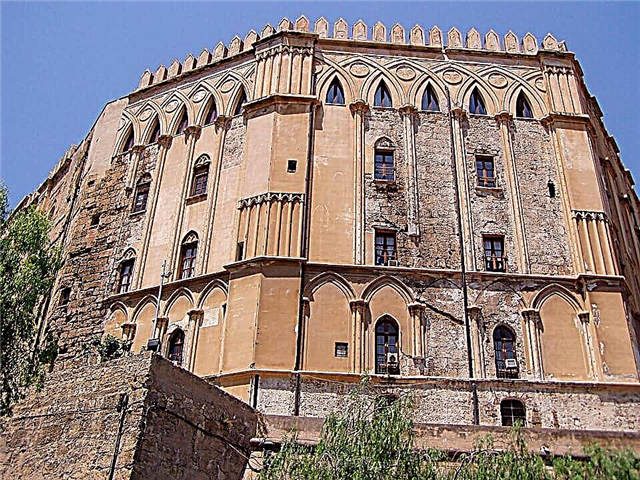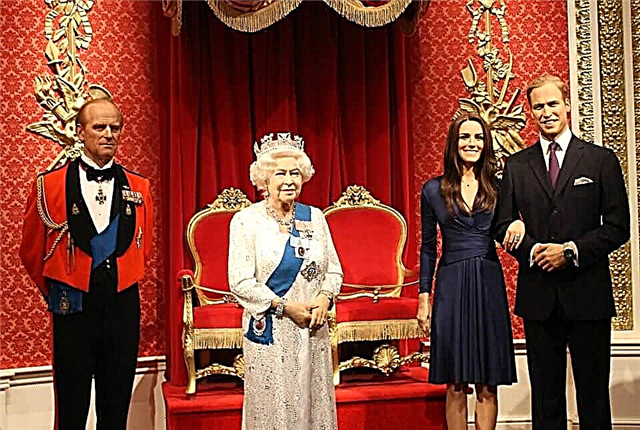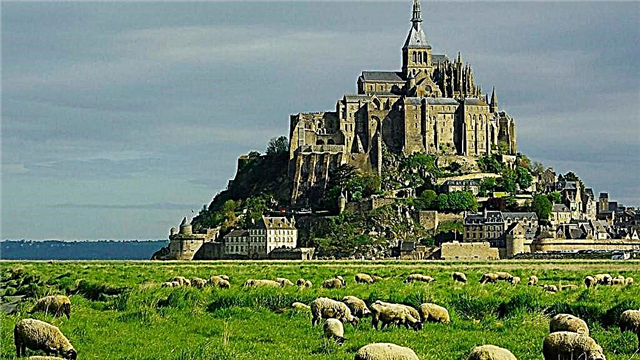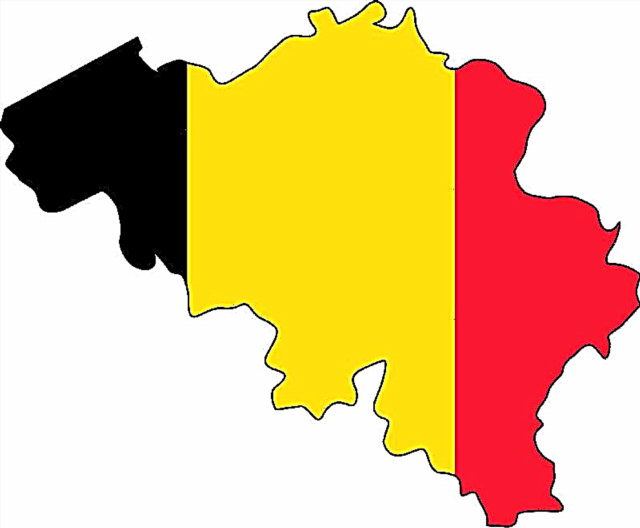Address: Russia Moscow
Foundation date: XIV century
Main attractions: Cathedral of the Meeting of the Vladimir Icon of the Mother of God, Cathedral of the Resurrection of Christ and the New Martyrs and Confessors of the Russian Church, Cathedral of the Meeting of the Vladimir Icon of the Mother of God in the bell tower
Coordinates: 55 ° 45'56.0 "N 37 ° 37'49.0" E
Cultural heritage site of Russia
Content:
In the very center of the capital, not far from the intersection of the Boulevard Ring and Bolshaya Lubyanskaya Street, there is an old Sretenskaya monastery. In its cathedral church you can see the amazingly beautiful wall paintings of the early 18th century, which are rightfully considered one of the masterpieces of ancient Russian art.

General view of the monastery
The history of the monastery in the XIV-XVII centuries
According to the chronicles, the monastery was founded in 1397 during the reign of the eldest son of Dmitry Donskoy, Grand Duke Vasily I. Wooden churches and cells were built near Kitai-Gorod in honor of the deliverance of Muscovites from the invasion of the troops of the ruthless Tamerlane.
For centuries, the monastery has played an important role in the spiritual life of the townspeople. The monastery lay on the road to Sergiev Posad, so everyone who went on pilgrimage to the Lavra stayed there.
Every year on August 26, a religious procession was performed, and the icon of the Vladimir Mother of God from the Kremlin's Assumption Cathedral was carried to the monastery. The crowded procession was very significant, and the great dukes took part in it, and later the Russian tsars. In addition, twice a year, religious processions were held through the monastery, dedicated to the deliverance of the city from the invasions of the Crimean Tatars.
As in other monasteries in Moscow, stone construction at the monastery began when Grand Duke John III Vasilyevich was in power. During his reign, two ancient churches - the icons of the Mother of God "Vladimirskaya" and Mary of Egypt were built of bricks.
In 1552, the squad of John IV the Terrible returned with triumph to the capital from the Kazan campaign. The Russian tsar made a stop at the walls of the monastery, participated in a thanksgiving service and awarded the monastery with generous gifts.

General view of the Cathedral of the New Martyrs and Confessors of the Russian Church on Blood
The monastery also distinguished itself during the Time of Troubles, which was difficult for the country. When Moscow was captured by the Polish-Lithuanian troops, Russian militias were stationed in the monastery. In the early spring of 1611, Dmitry Pozharsky was seriously wounded in battle. The exhausted prince was brought to the monastery, and the monks provided him with the necessary assistance.
A monastery in a new place
In the 17th century, due to the construction of a stone wall at Kitai-Gorod, the monastery was transferred to the part of Moscow where it is located today. It all started with the construction of a stone chapel, but the monastery grew rapidly. He received generous donations from the royal treasury, so in a short time churches and fraternal corps grew here.
Then the situation changed. In 1737, a massive fire broke out in the city center, and the fire destroyed several monastery buildings. In 1764, the Russian Empress Catherine II carried out a church reform. The monastery was declared superfluous, funding from the treasury was stopped, and no more than seven monks were allowed to live within the walls of the monastery.
In the 19th century, the Moscow metropolitans made a lot of efforts to revive the monastery life. When the war with the French began, church services were held in the monastery every day, and on the day of the Battle of Borodino, a crowded procession was held from the monastery. Then wounded Russian soldiers were brought to the monastery. The sick were nursed, and those who died of wounds found their last shelter in the monastery cemetery.
By the beginning of the last century, the monastery was widely known for its magnificent bells. On the territory of the monastery there was a hotel for pilgrims and a parish school, and representatives of famous noble families were buried in the local cemetery.

With the advent of Soviet power, the old monastery was not closed immediately. In the early 1920s, all valuable liturgical utensils, silver frames and old icons were removed from the churches. The abbot of the monastery, Bishop Illarion, was arrested and sent to exile near Arkhangelsk. Then he was returned to Moscow, but soon he was again taken into custody, tried and sent to Solovki.
The monastery was liquidated in 1926. An active anti-religious campaign was going on in the country, and all the monastery churches were destroyed, with the exception of the Sretensky Cathedral. Believers very much regretted the lost Church of Mary of Egypt - one of the most ancient in Moscow.
So that the solid building of the former cathedral was not empty, it was adapted as a hostel for the NKVD officers. Then a garage was located in the temple, and after it - the workshops of restorers. In the 1950s, a secondary school building was erected on the former monastery necropolis, where the graves of the participants in the 1812 war were located.
From 1958 to 1962, the facades of the Sretensky Church were restored. At that time, the church had not yet been restored to its rights, therefore, Orthodox crosses were not installed on the renovated church. Until 1990, there were restoration workshops inside the church, and outsiders were not allowed into the building.
In the early 1990s, the old cathedral was returned to believers. At first, it was made a parish, and members of the reviving church community gathered here. Two years later, the temple received the status of a courtyard of the famous Pskov-Pechersk monastery.

Cathedral of the Vladimir Icon of the Mother of God of the Presentation
In the summer of 1996, a man's monastery was restored on the basis of the cathedral. Gradually, a bell tower and a fence appeared on the territory. And since 1999, a school was opened in the monastery, which soon grew into a theological seminary.
Sretensky temple
A beautiful old church stands in the center of the monastery courtyard. It appeared in 1679 by decree of the Russian Tsar Fyodor Alekseevich and was built on the site of an older temple that had existed since the end of the XIV century. After the consecration, it was decided to expand the church, and arched porches were added to it on three sides. At the beginning of the 18th century, the western porch was converted into a church porch, and a chapel dedicated to the Nativity of John the Baptist appeared near the southern facade.
Despite the repairs and reconstruction, the appearance of the old building has changed slightly. Sretensky Cathedral is one of the best examples of Moscow-Yaroslavl temple architecture. It consists of a double-height quadrangle divided into three naves and three apses. Several years ago, a gallery with a small elegant belfry was added to the temple.
The outer walls of the cathedral are decorated with three arches, and large icons can be seen in the gaps between them. The quadruple is crowned with five onion domes. The massive drum supporting the central chapter is illuminated, while the rest are decorated with decorative windows.

View of the Cathedral of the Vladimir Icon of the Mother of God of the Meeting from the rear
Inside there is a five-tiered tyablo iconostasis, made in 1995. The lower part, or crypt, is decorated with white marble and mosaics. It contains a life-size replica of the famous Turin Shroud. Believers come here to pray in front of ancient icons and relics of Christian saints.
The unique frescoes of the Sretensky Church were made in 1707, during the transition to the Baroque. The customer for the wall paintings was the steward Semyon Fedorovich Griboyedov, and the temple was painted by talented iconographers invited from Kostroma and Yaroslavl.
The monastery today
Today, about 40 inhabitants live in the current monastery. The largest Orthodox publishing house in Russia is located here, and the monastery choir performs at festive concerts in different parts of the country and abroad. Church services at the monastery are held daily at 6.30 and 18.30.
The monastery has two sketes, an agricultural cooperative and has custody of an orphanage in the city of Mikhailov.Gradually, the building of the school, the hotel and several premises located along Rozhdestvensky Boulevard passed into his possession.
Quite recently, a new church dedicated to the New Martyrs of Russia was consecrated in the monastery. It is often called the "temple on blood" or "the temple of reconciliation" and is considered a tribute to the memory of all who were repressed and died during the years of active church persecution. Unfortunately, in order for the large-scale building to take its place, several historical buildings of the monastery had to be demolished.

Bell tower of the Cathedral of the Vladimir Icon of the Mother of God of the Presentation
How to get to the monastery
The monastery territory is located 1.5 km northeast of the Moscow Kremlin. It is easy to reach it in 15 minutes on foot from the metro stations "Turgenevskaya", "Chistye Prudy", "Sukharevskaya", "Tsvetnoy Boulevard", "Trubnaya", "Lubyanka" or "Kuznetsky Most". The monastery can also be reached by buses N6, M2 and M9. You need to get off at the Sretensky Gate stop.











